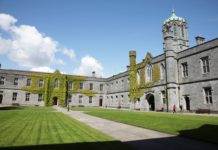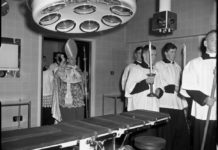Easter Monday 2010 saw a plaque unveiled in Dublin in memory of Seán Connolly, an Irish Citizen Army captain, and Molly O’Reilly, who raised the green flag over Liberty Hall at the start of the 1916 Rising. James Connolly Heron, whose great grandfather, the ICA leader James Connolly, commanded the republican forces in Dublin during Easter week, outlines the importance of such memorials in protecting Dublin’s revolutionary heritage.
The importance of placing plaques at locations and on buildings cannot be underestimated, especially in inner-city Dublin, an area directly linked through its buildings and its people to the struggle for independence.
Many locations directly linked to the Easter Rising have been lost to us over the years, many that are still with us are unmarked.
It was the removal of the 1916 plaque on Moore Street that directly led to the commencement of the campaign to save 16 Moore Street – the site of the final headquarters of the forces of the Irish Republic during Easter 1916 – from demolition.
The National Graves Association founded the Save 16 Moore Street Committee and as a direct result of campaigners’ efforts, numbers 14 to 17 Moore Street were declared protected buildings.
2010 marks the ‘Save 16 Moore Street’ campaign’s 10th anniversary. From a position where the entire street was set to be demolished, campaigners have managed to have numbers 14 to 17 designated as a 1916 national monument. The designation should, but does not, guarantee the preservation of the monument.
In late March, An Bord Pleanála approved a planning application that will lead to the demolition of Moore Street and the invasion of the boundary of the national monument. Buildings and the street and laneways directly associated with the withdrawal by the Republican forces from the GPO will be lost or altered beyond recognition – without public debate.
The fact that state bodies are party to this planning proposal is deeply disturbing. City management, city planners, officials in the Department of Heritage, Environment and Local Government – all public servants – are now party to the proposed demolition of a national monument.
This is despite the stated position of former Fianna Fáil Environment Minister Dick Roche that the State “must use every protective weapon in its statutory arsenal to protect a building of such immense historical significance”.
Current Environment Minister John Gormley has stated that he would consider all development proposals concerning Moore Street “with a view at all times to ensuring that the national monument is preserved for the future, and if possible, enhanced”.
The campaign has widespread support and continues to call for the national monument in its entirety to be preserved in honour of the men and women of 1916. We seek to ensure that the site of their last stand is not destroyed in the interests of mere commercial profit.
It is sadly ironic that the proposed developer Joe O’Reilly – a named member of the ‘Golden Circle’ linked to the Anglo Irish Bank scandal – is seeking permission to demolish a National Monument where a golden generation of men and women made their last stand for an Irish Republic committed to justice and equality for all.
SEÁN CONNOLLY
Born in 1883 into a Fenian family in Dublin, Connolly was an Irish teacher and a founder member of the Na Fianna GAA club. As an Abbey Theatre actor, he knew many of the leading figures of the cultural revival, including W.B. Yeats and Lady Gregory.
At the time of the Rising, he was living with his wife Christina Swanzy and three children in Philipsburgh Avenue.
He joined the Citizens’ Army, a defence force for workers, upon its formation in 1913. In 1914, James Connolly reorganized the army into a revolutionary organization and Seán Connolly was appointed a captain.
At the start of Easter Week 1916, Seán Connolly led the ICA attack on City Hall but was fatally wounded by a British sniper. His four brothers and one sister also saw action with the ICA during Easter Week. Only his wife and youngest child were present when he was laid to rest in Glasnevin Cemetery, most of the rest of the family had been imprisoned or were on the run.
The plaque was unveiled at 58/59 Lower Seán McDermott Street, where the house of Captain Seán Connolly once stood.
MOLLY O’REILLY
Young Molly O’Reilly was given the honour of hoisting the green flag above Liberty Hall by Commandant James Connolly to mark the start of the ICA’s uprising. In The History of the Irish Citizen Army, by R.M. Fox, it is recorded:
‘In front of the hall itself, the Citizen Army cleared a space and formed up on three sides of the square. Inside this square was the women’s section, the boys’ scouts’ corps under Captain W. Carpenter, and the Fintan Lalor Pipe Band. Captain C. Poole and a Colour Guard of sixteen men escorted the colour bearer, Miss Molly O’ Reilly of the Women Workers’ Union who was also a member of the Citizen Army. ….. “I noticed,” said a member of the Colour Guard, “that some men, old and middle-aged, and a great number of women were crying, and I knew then that this was not in vain and that they all realised what was meant by the hoisting of the flag.” ’




